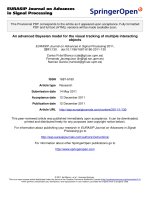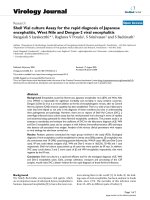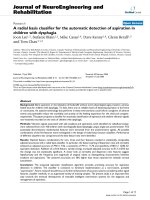Báo cáo toán học: " Vanishing heat conductivity limit for the 2D Cahn-Hilliard-Boussinesq system" docx
Bạn đang xem bản rút gọn của tài liệu. Xem và tải ngay bản đầy đủ của tài liệu tại đây (180.19 KB, 9 trang )
This Provisional PDF corresponds to the article as it appeared upon acceptance. Fully formatted
PDF and full text (HTML) versions will be made available soon.
Vanishing heat conductivity limit for the 2D Cahn-Hilliard-Boussinesq system
Boundary Value Problems 2011, 2011:54 doi:10.1186/1687-2770-2011-54
Zaihong Jiang ()
Jishan Fan ()
ISSN 1687-2770
Article type Research
Submission date 18 October 2011
Acceptance date 22 December 2011
Publication date 22 December 2011
Article URL />This peer-reviewed article was published immediately upon acceptance. It can be downloaded,
printed and distributed freely for any purposes (see copyright notice below).
For information about publishing your research in Boundary Value Problems go to
/>For information about other SpringerOpen publications go to
Boundary Value Problems
© 2011 Jiang and Fan ; licensee Springer.
This is an open access article distributed under the terms of the Creative Commons Attribution License ( />which permits unrestricted use, distribution, and reproduction in any medium, provided the original work is properly cited.
Vanishing heat conductivity limit for the
2D Cahn-Hilliard-Boussinesq system
Zaihong Jiang
∗1
and Jishan Fan
2
1
Department of Mathematics, Zhejiang Normal University,
Jinhua 321004, People’s Republic of China
2
Department of Applied Mathematics, Nanjing Forestry University,
Nanjing 210037, People’s Republic of China
∗
Corresponding author:
Email address:
Abstract
This article studies the vanishing heat conductivity limit for the 2D Cahn-
Hilliard-boussinesq system in a bounded domain with non-slip boundary condi-
tion. The result has been proved globally in time.
2010 MSC: 35Q30; 76D03; 76D05; 76D07.
Keywords: Cahn–Hilliard–Boussinesq; inviscid limit; non-slip boundary con-
dition.
1 Introduction
Let Ω ⊆ R
2
be a bounded, simply connected domain with smooth boundary ∂Ω, and
n is the unit outward normal vector to ∂Ω. We consider the following Cahn-Hilliard-
1
Boussinesq system in Ω × (0, ∞) [1]:
∂
t
u + (u · ∇)u + ∇π −∆u = µ∇φ + θe
2
, (1.1)
div u = 0, (1.2)
∂
t
θ + u · ∇θ = ∆θ, (1.3)
∂
t
φ + u ·∇φ = ∆µ, (1.4)
−∆φ + f
(φ) = µ, (1.5)
u = 0, θ = 0,
∂φ
∂n
=
∂µ
∂n
= 0 on ∂Ω × (0, ∞), (1.6)
(u, θ, φ)(x, 0) = (u
0
, θ
0
, φ
0
)(x), x ∈ Ω, (1.7)
where u, π, θ and φ denote unknown velocity field, pressure scalar, temperature of the
fluid and the order parameter, respectively. > 0 is the heat conductivity coefficient
and e
2
:= (0, 1)
t
. µ is a chemical potential and f (φ) :=
1
4
(φ
2
− 1)
2
is the double well
potential.
When φ = 0, (1.1), (1.2) and (1.3) is the well-known Boussinesq system. In [2]
Zhou and Fan proved a regularity criterion ω
.
= curlu ∈ L
1
(0, T ;
˙
B
0
∞,∞
) for the 3D
Boussinesq system with partial viscosity. Later, in [3] Zhou and Fan studied the
Cauchy problem of certain Boussinesq −α equations in n dimensions with n = 2 or
3. We establish regularity for the solution under ∇u ∈ L
1
(0, T ;
˙
B
0
∞,∞
). Here
˙
B
0
∞,∞
denotes the homogeneous Besov space. Chae [4] studied the vanishing viscosity limit
→ 0 when Ω = R
2
. The aim of this article is to prove a similar result. We will prove
that
Theorem 1.1. Let (u
0
, θ
0
) ∈ H
1
0
∩ H
2
, φ
0
∈ H
4
, div u
0
= 0 in Ω and
∂φ
0
∂n
=
∂µ
0
∂n
= 0
on ∂Ω. Then, there exists a positive constant C independent of such that
u
L
∞
(0,T ;H
2
)
≤ C, θ
L
∞
(0,T ;H
2
)
≤ C,
φ
L
∞
(0,T ;H
4
)
≤ C, ∂
t
(u
, θ
, φ
)
L
2
(0,T ;L
2
)
≤ C,
(1.8)
for any T > 0, which implies
(u
, θ
, φ
) → (u, θ, φ) strongly in L
2
(0, T ; H
1
) when → 0. (1.9)
Here, (u, θ, φ) is the solution of the problem (1.1)–(1.7) with = 0.
2 Proof of Theorem 1.1
Since (1.9) follows easily from (1.8) by the Aubin-Lions compactness principle, we only
need to prove the a priori estimates (1.8). From now on, we will drop the subscript
and throughout this section C will be a constant independent of .
First, by the maximum principle, it follows from (1.2), (1.3), and (1.6) that
θ
L
∞
(0,T ;L
∞
)
≤ θ
0
L
∞
≤ C. (2.1)
2
Testing (1.3) by θ, using (1.2) and (1.6), we see that
1
2
d
dt
θ
2
dx +
|∇θ|
2
dx = 0,
whence
√
θ
L
2
(0,T ;H
1
)
≤ C. (2.2)
Testing (1.1) and (1.4) by u and µ, respectively, using (1.2), (1.6), (2.1), and
summing up the result, we find that
d
dt
1
2
u
2
+
1
2
|∇φ|
2
+ f (φ)dx +
|∇u|
2
+ |∇µ|
2
dx
=
θe
2
udx ≤ θ
L
2
u
L
2
≤ Cu
L
2
,
which gives
φ
L
∞
(0,T ;H
1
)
≤ C, (2.3)
u
L
∞
(0,T ;L
2
)
+ u
L
2
(0,T ;H
1
)
≤ C, (2.4)
∇µ
L
2
(0,T ;L
2
)
≤ C. (2.5)
Testing (1.4) by φ, using (1.2), (1.5) and (1.6), we infer that
1
2
d
dt
φ
2
dx +
|∆φ|
2
dx =
(φ
3
− φ)∆φdx
= −3
φ
2
|∇φ|
2
dx −
φ∆φdx ≤ −
φ∆φdx
≤
1
2
|∆φ|
2
dx +
1
2
φ
2
dx,
which leads to
φ
L
2
(0,T ;H
2
)
≤ C. (2.6)
We will use the following Gagliardo-Nirenberg inequality:
φ
2
L
∞
≤ Cφ
L
6
φ
H
2
. (2.7)
3
It follows from (2.6), (2.7), (2.5), (2.3) and (1.5) that
T
0
|∇∆φ|
2
dxdt
=
T
0
|∇(f
(φ) − µ)|
2
dxdt
≤ C
T
0
|∇µ|
2
dxdt + C
T
0
|∇(φ
3
− φ)|
2
dxdt
≤ C + C
T
0
φ
4
|∇φ|
2
dxdt
≤ C + C∇φ
2
L
∞
(0,T ;L
2
)
T
0
φ
4
L
∞
dt
≤ C + C
T
0
φ
2
L
6
φ
2
H
2
dt
≤ C + Cφ
2
L
∞
(0,T ;H
1
)
T
0
φ
2
H
2
dt ≤ C, (2.8)
which yields
φ
L
2
(0,T ;H
3
)
≤ C, (2.9)
φ
L
4
(0,T ;L
∞
)
≤ C, (2.10)
∇φ
L
2
(0,T ;L
∞
)
≤ C. (2.11)
Testing (1.4) by ∆
2
φ, using (1.5), (2.4), (2.3), (2.10) and (2.11), we derive
1
2
d
dt
|∆φ|
2
dx +
|∆
2
φ|
2
dx
= −
u · ∇ φ ·∆
2
φdx +
∆(φ
3
− φ) ·∆
2
φdx
≤ u
L
2
∇φ
L
∞
∆
2
φ
L
2
+ ∆(φ
3
− φ)
L
2
∆
2
φ
L
2
≤ C∇φ
L
∞
∆
2
φ
L
2
+C(φ
2
L
∞
∆φ
L
2
+ φ
L
∞
∇φ
L
∞
∇φ
L
2
+ ∆φ
L
2
)∆
2
φ
L
2
≤ C∇φ
L
∞
∆
2
φ
L
2
+C(φ
2
L
∞
∆φ
L
2
+ φ
H
2
∇φ
L
∞
+ ∆φ
L
2
)∆
2
φ
L
2
≤
1
2
∆
2
φ
2
L
2
+ C∇φ
2
L
∞
+ Cφ
4
L
∞
∆φ
2
L
2
+C∇φ
2
L
∞
φ
2
H
2
+ C∆φ
2
L
2
,
which implies
φ
L
∞
(0,T ;H
2
)
+ φ
L
2
(0,T ;H
4
)
≤ C. (2.12)
4
Testing (1.1) by −∆u + ∇π, using (1.2), (1.6), (2.12), (2.1) and (2.4), we reach
1
2
d
dt
|∇u|
2
dx +
(−∆u + ∇π)
2
dx
=
(µ∇φ + θe
2
− u ·∇u)(−∆u + ∇π)dx
≤ (µ
L
2
∇φ
L
∞
+ θ
L
2
+ u
L
4
∇u
L
4
) − ∆u + ∇π
L
2
≤ C(∇φ
L
∞
+ 1 + u
1/2
L
2
∇u
1/2
L
2
· ∇u
1/2
L
2
∆u
1/2
L
2
) − ∆u + ∇π
L
2
≤ C∇φ
2
L
∞
+ C + C∇u
4
L
2
+
1
2
− ∆u + ∇π
2
L
2
,
which yields
u
L
∞
(0,T ;H
1
)
+ u
L
2
(0,T ;H
2
)
≤ C. (2.13)
Here, we have used the Gagliardo-Nirenberg inequalities:
u
2
L
4
≤ Cu
L
2
∇u
L
2
,
∇u
2
L
4
≤ C∇u
L
2
u
H
2
,
and the H
2
-theory of the Stokes system:
u
H
2
+ π
H
1
≤ C −∆u + ∇π
L
2
. (2.14)
Similarly to (2.13), we have
∂
t
u
L
2
(0,T ;L
2
)
≤ C. (2.15)
(1.1), (1.2), (1.6) and (1.7) can be rewritten as
∂
t
u − ∆u + ∇π = g := µ∇φ + θe
2
− u ·∇u, in Ω × (0, ∞),
u = 0, on ∂Ω × (0, ∞),
u(x, 0) = u
0
(x).
Using (2.12), (2.1), (2.13), and the regularity theory of Stokes system, we have
∂
t
u
L
2
(0,T ;L
p
)
+ u
L
2
(0,T ;W
2,p
)
≤ Cg
L
2
(0,T ;L
p
)
≤ Cµ
L
2
(0,T ;L
∞
)
∇φ
L
∞
(0,T ;L
p
)
+ Cθ
L
∞
(0,T ;L
∞
)
+Cu
L
∞
(0,T ;L
2p
)
∇u
L
2
(0,T ;L
2p
)
≤ C, (2.16)
for any 2 < p < ∞.
(2.16) gives
∇u
L
2
(0,T ;L
∞
)
≤ C. (2.17)
It follows from (1.3) and (1.6) that
∆θ = 0 on ∂Ω ×(0, ∞). (2.18)
5
Applying ∆ to (1.3), testing by ∆θ, using (1.2), (1.6), (2.16), (2.17) and (2.18), we
obtain
1
2
d
dt
|∆θ|
2
dx +
|∇∆θ|
2
dx
= −
(∆(u · ∇θ) − u∇∆θ)∆θdx
≤ C(∆u
L
4
∇θ
L
4
+ ∇u
L
∞
∆θ
L
2
)∆θ
L
2
≤ C(∆u
L
4
+ ∇u
L
∞
)∆θ
2
L
2
,
which implies
θ
L
∞
(0,T ;H
2
)
+
√
θ
L
2
(0,T ;H
3
)
≤ C. (2.19)
It follows from (1.3), (1.6), (2.19) and (2.13) that
∂
t
θ
L
∞
(0,T ;L
2
)
≤ C. (2.20)
Taking ∂
t
to (1.4) and (1.5), testing by ∂
t
φ, using (1.2), (1.6), (2.12), and (2.15),
we have
1
2
d
dt
|∂
t
φ|
2
dx +
|∆∂
t
φ|
2
dx
= −
∂
t
u · ∇ φ ·∂
t
φdx +
∆(3φ
2
∂
t
φ − ∂
t
φ) · ∂
t
φdx
= −
∂
t
u · ∇ φ ·∂
t
φdx +
(3φ
2
∂
t
φ − ∂
t
φ)∆∂
t
φdx
≤ ∂
t
u
L
2
∇φ
L
∞
∂
t
φ
L
2
+ (3φ
2
L
∞
+ 1)∂
t
φ
L
2
∆∂
t
φ
L
2
≤ ∂
t
u
L
2
∇φ
L
∞
∂
t
φ
L
2
+
1
2
∆∂
t
φ
2
L
2
+ C∂
t
φ
2
L
2
,
which gives
∂
t
φ
L
∞
(0,T ;L
2
)
+ ∂
t
φ
L
2
(0,T ;H
2
)
≤ C. (2.21)
By the regularity theory of elliptic equation, it follows from (1.4), (1.5), (1.6),
(2.21), (2.13) and (2.12) that
φ
L
∞
(0,T ;H
4
)
≤ C∆φ
L
∞
(0,T ;H
2
)
≤ Cµ −f
(φ)
L
∞
(0,T ;H
2
)
≤ Cµ
L
∞
(0,T ;H
2
)
+ Cf
(φ)
L
∞
(0,T ;H
2
)
≤ C∆µ
L
∞
(0,T ;L
2
)
+ Cf
(φ)
L
∞
(0,T ;H
2
)
≤ C∂
t
φ + u ·∇φ
L
∞
(0,T ;L
2
)
+ Cf
(φ)
L
∞
(0,T ;H
2
)
≤ C∂
t
φ
L
∞
(0,T ;L
2
)
+ Cu
L
∞
(0,T ;L
4
)
∇φ
L
∞
(0,T ;L
4
)
+Cf
(φ)
L
∞
(0,T ;H
2
)
≤ C. (2.22)
6
Taking ∂
t
to (1.1), testing by ∂
t
u, using (1.2), (1.6), (2.17), (2.22), (2.21) and (1.5),
we conclude that
1
2
d
dt
|∂
t
u|
2
dx +
|∇∂
t
u|
2
dx
= −
∂
t
u · ∇u · ∂
t
udx +
(∂
t
µ · ∇φ + µ ·∇∂
t
φ + ∂
t
θe
2
)∂
t
udx
≤ ∇u
L
∞
∂
t
u
2
L
2
+ (∂
t
u
L
2
∇φ
L
∞
+ µ
L
∞
∇∂
t
φ
L
2
+ ∂
t
θ
L
2
)∂
t
u
L
2
≤ ∇u
L
∞
∂
t
u
2
L
2
+ C(∆∂
t
φ
L
2
+ ∂
t
(φ
3
− φ)
L
2
+ ∇∂
t
φ
L
2
+ 1)∂
t
u
L
2
,
which implies
∂
t
u
L
∞
(0,T ;L
2
)
+ ∂
t
u
L
2
(0,T ;H
1
)
≤ C. (2.23)
Using (2.23), (2.22), (2.1), (2.13), (1.1), (1.2), (1.6) and the H
2
-theory of the Stokes
system, we arrive at
u
L
∞
(0,T ;H
2
)
≤ C.
This completes the proof.
Competing interests
The authors declare that they have no competing interests.
Authors’ contributions
All authors read and approved the final manuscript.
Acknowledgment
This study was supported by the NSFC (No. 11171154) and NSFC (Grant No.
11101376).
References
[1] Boyer, Franck: Mathematical study of multi-phase flow under shear through order
parameter formulation. Asymptot. Anal. 20, 175–212 (1999)
[2] Fan, Jishan; Zhou, Yong: A note on regularity criterion for the 3D Boussinesq
system with partial viscosity. Appl. Math. Lett. 22, 802–C805 (2009)
[3] Zhou, Yong; Fan, Jishan: On the Cauchy problems for certain Boussinesq- α
equations. Proc. R. Soc. Edinburgh Sect. A 140, 319–C327 (2010)
7
[4] Chae, Dongho: Global regularity for the 2D Boussinesq equations with partial
viscosity terms. Adv. Math. 203, 497–513 (2006).
8









